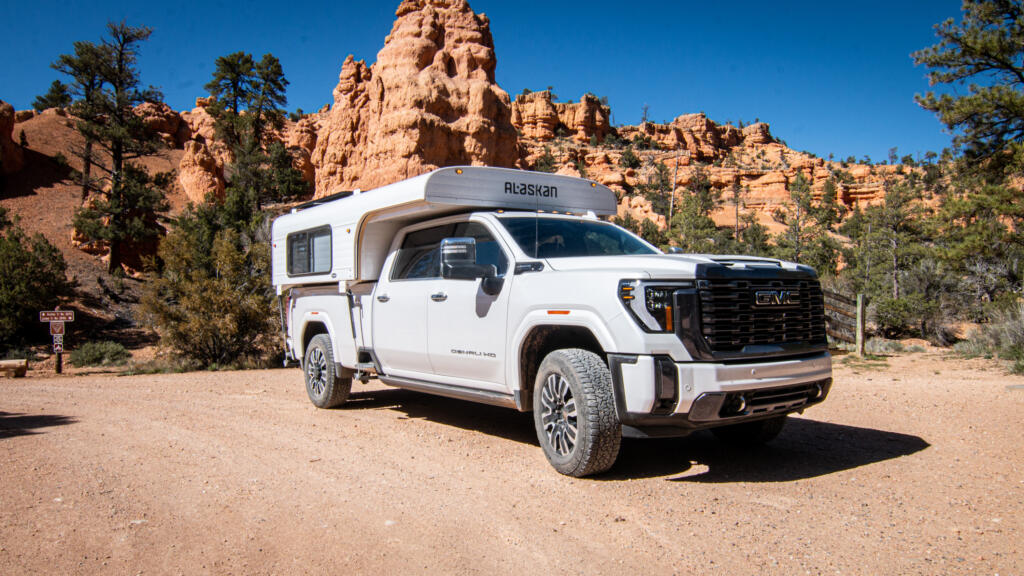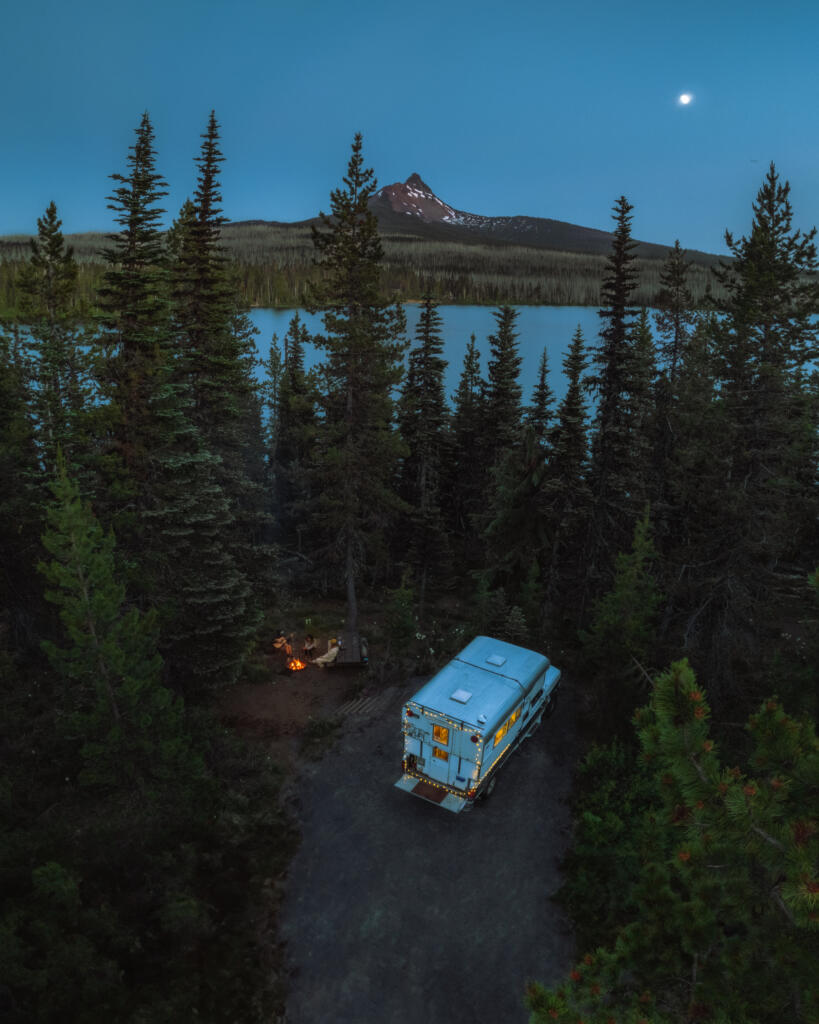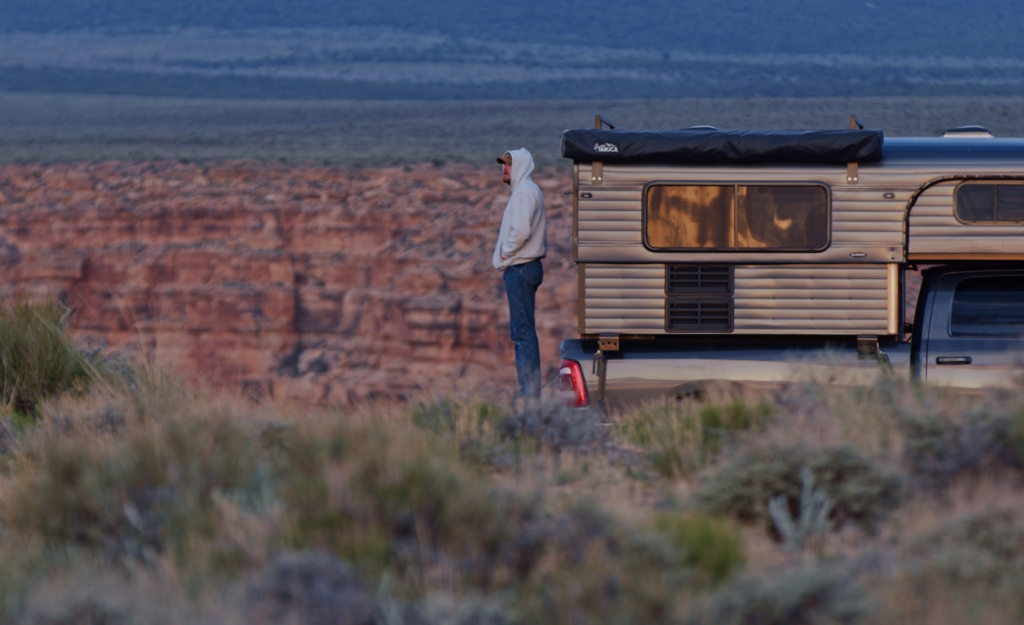Staying Safe in Your Alaskan
Thinking about heading out in your Alaskan Camper? Whether you’re flying solo or with a group, refresh yourself with some of our safety tips to make sure you’re packing smart, preparing for the worst, and avoiding risky situations. We’ll also cover how to avoid encounters with wildlife and insects, plus explore some tech that helps us feel more confident—especially when we’re out there alone. Also, for some reason, we’ve included a variety of Mark Twain quotes that only loosely apply to each section. You’re welcome?
First, Some Alaskan LoVe
If you thought we weren’t going to start this post gushing about the inherent safety of an Alaskan Camper, you’d be wrong. They’re designed to be secure, featuring a robust, solid-frame construction and superior insulation—R11 in the walls and R13 in the ceiling—to maintain a comfortable internal climate regardless of external conditions. Our durable, hard-sided pop-up design provides enhanced protection from both harsh weather and wildlife, ensuring a secure and cozy environment for every adventure. Okay, we went a little hard into pitch-mode, there. Ahem.
Preparation
“It usually takes me more than three weeks to prepare a good impromptu speech.” Here come the Mark Twain quotes—let’s talk about proper prep to keep your trip safe and enjoyable.
Camper/Vehicle Maintenance
Before setting off, conduct a thorough walk-around of your Alaskan Camper. Ensure the telescopic roof and awnings are securely retracted and all connections are tightly fastened. Check the fluid levels and inspect the tires for wear, cracks, or uneven tread, confirming they’re inflated to the manufacturer’s specifications for optimal fuel efficiency and reduced blowout risk. Lastly, make sure all critical systems, including brakes and lights, are functioning properly before splitting.
Route and Location Planning
Carefully plan your route, keeping an eye on traffic conditions and construction updates with real-time GPS tools. For remote camping, evaluate potential sites using satellite imagery to ensure accessibility and safety. Take your time, be vigilant, and consider if you can spot approaching visitors in advance and whether your setup allows for a quick departure. It’s also wise to familiarize yourself with the local area’s emergency services including the distance to the nearest hospital.
Safety Essentials: Tools
At a minimum, pack a tire pressure gauge, spare batteries, a battery charger, and wheel chocks or blocks. Don’t forget motor oil and other essential fluids, jumper cables, duct tape, and electrical tape for unexpected repairs.
Safety Essentials: Safety and Emergency Gear
Prioritize safety by carrying a well-stocked first-aid kit, fire extinguisher, and a collapsible shovel for various emergencies. Include flashlights and a surge protector with extension cords to manage any electrical needs, and a tarp for additional shelter or ground cover, if necessary.
Safety Essentials: Documentation
Carry documents like vehicle insurance cards, titles, license, registration information, and roadside assistance details. It’s also smart to include health-related information such as insurance documents, current prescription medications, allergies, names and phone numbers of treating doctors, hospitalization and surgical histories, and legal papers related to medical care such as living wills, powers of attorney, and health care surrogates. If traveling with pets, keep their inoculation records, food and allergy lists, medication details, and medical histories handy. Also, have the contact information for your family’s veterinarian.
Okay, we admit that was a lot, but at the very least carry simple vehicle and health info and build your folder of documents from there.

Campsite safety
“It’s better to be safe 100 times than dead once.” Heh—that’s our second Twain quote, however, it’s rumored not to be his saying, but we’re going with it. Let’s review some tips to stay safe once you’re out there roughing it.
Cooperation Makes it Happen
When setting up camp, make sure you’ve got a reliable way to communicate. Consider a satellite phone or Starlink for consistent internet, especially if you’re out in the sticks. It’s equally important to keep someone informed of your whereabouts. Not only the area you’re camping but if you’re hiking, take a photo of your starting point, particularly of any trail signs, and send it to someone. Cell service can be unreliable, and each year, people get lost because their phones fail or they’re out of service range. Always let a friend or family member know exactly where you are just in case of emergencies.
Social Media and Privacy
It’s also wise to manage your social media footprint carefully while camping. Refrain from posting your location in real-time on platforms like Facebook and Instagram. If you choose to share your adventures, do so after you’ve left the location. This helps in avoiding unwanted attention and keeps your current whereabouts private.
Creating an Impression of Company
Especially if you’re camping solo it can give you some extra confidence to give the impression that you’re not alone. You can leave multiple chairs out, place different sized shoes outside your door, or even display extra glasses on the dashboard. These small cues can deter unwanted visitors by suggesting that you are part of a group.

Animals, Insects, and Reptiles
“It’s not the size of the dog in the fight, it’s the size of the fight in the dog.” Okay, this barely applies to this section, we’re just forcing in Mark Twain quotes too much at this point. Let’s review some tips around critters and campsite pests and—if you’re feeling crazy—here’s a related blog about setting up an outdoor kitchen that includes some advice on keeping your campsite clean and organized.
Obviously, Dogs are Great
If feasible, consider bringing a dog along or displaying signs that hint at a dog’s presence, like a worn water dish or a “Beware of Dog” sign. Dogs not only offer companionship but also serve as a deterrent for wildlife and unwelcome visitors. Always ensure your dog has proper identification and is never left unattended. This helps keep them safe and makes it easier to reunite if you get separated.
Insect Precautions
When camping in your Alaskan Camper, it’s essential to understand your susceptibility to insect bites and take preventative measures. Spray the door frame and screens with insect repellent to help keep pests at bay. When outside, it’s advisable to wear clothing that covers most of your skin and apply insect repellent liberally. If you’re allergic to bee stings, carry necessary medications and be mindful of the ground for ant hills when setting up your campsite.
Reptile Awareness
Reptiles, including poisonous snakes, are commonly found in many camping areas. These creatures pose the greatest threat to curious children and pets who may unknowingly disturb their habitat. Always supervise your children and pets closely in areas known for poisonous snakes. Reptiles are particularly active during warmer seasons and transition periods like Spring and Fall as they move to and from their winter nests. Always shake out shoes and check containers before use, and avoid placing hands in areas where you can’t see.
Bear Encounters
Managing bear interactions starts with prevention. Secure all food in a bear-proof location and maintain a clean campsite to avoid attracting bears. Remember, your safety also depends on the practices of nearby campers—so choose your campsite and neighbors wisely. If you do encounter a bear, stay calm, avoid eye contact, and maintain a distance of at least 100 yards. If a bear charges, we read that it’s likely a bluff (well, that’s still scary), and having bear spray on you can definitely provide peace of mind and at least some defense during close encounters.

Time to mosey
That was fun. We’ll catch you next time and be sure not to wear out our welcome reciting Twain(isms). If you’re looking to continue reading, try our camping breakfast ideas blog or even our off-grid camping in SoCal recommendations. See you next time, camper!
